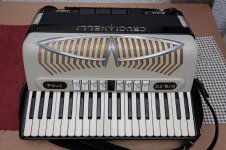Dingo40
Been here for ages!
Many accordions feature bits of bright-work ( logos, decorative items) which on casual inspection appear to be chromed metal but turn out to be "chromed " plastic.
Much of this surface "chromed finish "
often degrades over time and becomes shoddy, spoiling the cosmetic appearance of the instrument.
While watching an episode of "Wheeler Dealers, "I became aware that, nowadays, there has become available a variety of products that can be sprayed on or applied with a felt pen which closely mimic chrome plating, such as this, for one:
Hmm, just a thought

Much of this surface "chromed finish "
often degrades over time and becomes shoddy, spoiling the cosmetic appearance of the instrument.
While watching an episode of "Wheeler Dealers, "I became aware that, nowadays, there has become available a variety of products that can be sprayed on or applied with a felt pen which closely mimic chrome plating, such as this, for one:
Hmm, just a thought


